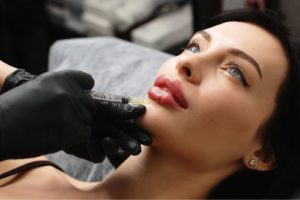With collagen degradation on the rise as the natural aging process takes hold, non-invasive procedures that make a difference in the skin continue to rise. One of the most effective solutions is collagen-stimulating treatments like Ultherapy and radiofrequency (RF) microneedling. When it comes to Ultherapy vs. RF microneedling, these treatments are different, they are two of the most effective procedures to visibly plump the skin and maintain its elasticity without a single cut, scar, or incision. That’s why these solutions are favored by patients time and time again.
However, Ultherapy and RF microneedling work entirely differently from one another. Where Ultherapy uses ultrasound energy to incite new collagen production, RF microneedling creates tiny microscopic wounds to stimulate collagen creation, while RF energy helps tighten loose skin. That means Ultherapy creates more of a lifting effect in slack skin, while RF microneedling improves the skin’s surface and firms it.
So, what else do you need to know about Ultherapy vs. RF microneedling? Well, plenty.
Is RF microneedling better than Ultherapy?
RF microneedling works differently than Ultherapy, and many skin experts prefer it over Ultherapy. While both treatments help create new collagen for better-looking, firmer skin, Ultherapy (known initially as Ulthera) targets saggy skin on the neck, face, chin, and brows. It also helps improve the appearance of lines and wrinkles on the chest. Ultherapy delivers a dose of concentrated ultrasound energy to three different layers of the skin to incite the formation of new collagen. The depths that the energy reaches make the treatment more painful, which is why plenty of practitioners prefer RF microneedling instead. But because Ultherapy is delivered deeper, some believe it’s more effective for wrinkles and more extreme sagging skin.
Like Ultherapy, RF microneedling is safe for all skin tones and types. It is also effective for tightening slack skin on the face, neck, and chest and problem areas on the body. But where RF microneedling goes one step further, it improves the skin’s texture to smooth its surface. During an RF microneedling session, the device tip creates tiny holes in the skin that, as they heal, produce new collagen and tighter, smoother skin. This is why RF microneedling is a better option for treating more superficial lines and scars.
RF microneedling is purportedly more tolerable when performed with topical anesthesia making it a more viable option. The results, overall, are seen faster with RF microneedling than with Ultherapy.
Can you do microneedling after Ultherapy?
Technically, yes. Most non-invasive treatments are compatible with RF microneedling. But a series of RF microneedling treatments should do a good enough job that Ultherapy may not be necessary. The results will likely differ if you stack one Ultherapy (all that’s needed) on top of a series of RF microneedling treatments.
Ultherapy after microneedling doesn’t change how the treatment is performed or works. The treatment still utilizes ultrasound technology and delivers it to the deeper layers of the skin to provide a tightening and lifting effect.
To determine if Ultherapy, or another type of aesthetic treatment, is recommended following microneedling, schedule a consultation with our team today!
Does RF microneedling really tighten skin?
Yes, RF microneedling can help tighten the skin, although it’s to a different degree than Ultherapy offers. RF microneedling sends RF energy under the skin to stimulate collagen production, tightening the skin. But that’s not all RF microneedling is suitable for. It also smooths out fine lines, wrinkles, enlarged pores, stretch marks, and even acne scars.
Professional RF microneedling penetrates deep down to the subdermal layers of tissue to coagulate fat and heat the deeper layers of skin. The microscopic wounds on the skin’s surface create channels for proper energy distribution. Together, this approach debulks areas where excess fat is present while firming loose skin. In addition, RF heat forces the existing collagen fibers to reorganize themselves so that they are stronger, healthier, and tighter, contributing to the appearance of firmer, healthier-looking skin.
Can Ultherapy cause fat loss?
One of the most significant downsides of using Ultherapy is the potential for facial fat loss–plenty of magazine articles and dermatologists draw caution to the treatment for this very reason. However, while there’s no scientific proof that the treatment leads to fat loss, numerous experts have seen patient cases of permanent fat loss when using Ultherapy too deep on the face. Reinstating lost volume can only be done surgically with fat. Fillers can also be used to help volumize fat-deficient areas of the face.
Is Ultherapy more painful than RF microneedling?
Because of the deep tissue heating, Ultherapy is said to be more painful than RF microneedling. However, RF microneedling may be more comfortable for most patients since the needles only penetrate the uppermost layers of the skin, and the RF energy is delivered to the top and middle layers of the skin.
What’s the downtime associated with Ultherapy vs. RF microneedling?
Hands down, Ultherapy comes with a more intense recovery period and more downtime than RF microneedling. That’s because Ultherapy uses microfocused ultrasound to create a tightening effect very deep under the skin, which causes more pain, swelling, and bruising.
With RF microneedling, there’s no significant downtime or recovery, although it’s normal for the skin to feel tight, dry, and a little red for a few days. There may also be some pinpoint bleeding from the needle inserted into the skin, but it will quickly subside. RF microneedling also benefits patients who can’t afford any downtime.
What are the results of Ultherapy vs. RF microneedling?
The results of Ultherapy vs. RF microneedling are somewhat similar but also different. While both procedures help improve skin elasticity and its texture and tone, there’s more of a lifting effect with one Ultherapy treatment. With RF microneedling, the results from a series of treatments focus more on the skin quality and tone as well as a firming effect.









